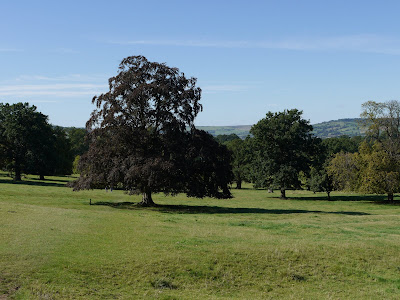After a break for summer holidays we resume our walk along the Cotswold Way with Merv and Pud. We started from the Mount Inn in Stanton, walked down the street and turn left into Stanford's other main street. Both are delightfully full of lovely houses on golden Cotswold stone. Stanford is less well-known than Broadway, and smaller, but certainly as pretty.
We now crossed a series of fields, but the feel was of walking through the park of a great house.

And in due course we came to Stanway, which has a great house, Stanway House, so perhaps it was its park we had been walking through. We first passed St Peter's church which dates from the 12th century, although the interior reflects a late-Victorian restoration.
Just a short way further on is the remarkable gateway of Stanway House, which was sadly closed for the year (it is only open June-August).

Pevsner comments that it looks Jacobean, but may date from as late as 1700. The house itself is Jacobean, with 18th and 19th century additions. According to its website, the glory of the Stanway water garden is the single-jet fountain in the Canal, opened in 2004. It rises to over 300 feet, making it the tallest fountain in Britain and the tallest gravity fountain in the world. We plan to go back next summer to see it and the house.
From Stanway the route leads to the hamlet of Wood Stanway. From here the you climb past a series of fields with obvious signs of medieval plough and furrow cultivation. This field was especially interesting: it had been leveled off, but the furrows can still be seen beneath the grass.

The path climbed steadily, but offered fine views back towards the north.

At the top, the helpfully-provided seat was already occupied, so we headed on to Stumps Cross where we turned right beside fields to pass Beckbury Camp, an iron age hill fort. A bit further on is a stone monument. There are many other blog posts and photos bout it, but no-one seems to know what it commemorates.
From here you begin a steady descent to Hailes Abbey.

The ruins of this Cistercian Abbey sit in a tranquil location. The Cistercians were an offshoot of the Benedictines whose goal was to return to the strict observance of the rule of St Benedict. Their name comes from the first monastery they founded which was Citeaux near Dijon in France in 1098.
Hailes Abbey was founded by Richard, Earl of Cornwall, brother of Henry III in 1246. Needless to say, the destruction of the abbey was part of Henry VIII's dissolution of the monasteries. The site was given to his surviving queen, Katherine Parr and a country house was later built on the site, but by 1794 it too was a ruin.
Almost opposite is the tiny, rather abandoned, church. It dates from about 1130, so about a hundred years before the abbey.

There are some lovely (Pevsner says 13th century) wall paintings, of which this is the best preserved.

Conditions: warm and sunny.
Distance: about 6 miles.
Maps: Explorer OL45 (The Cotswolds).
Rating: four stars. Great views, interesting buildings.

No comments:
Post a Comment